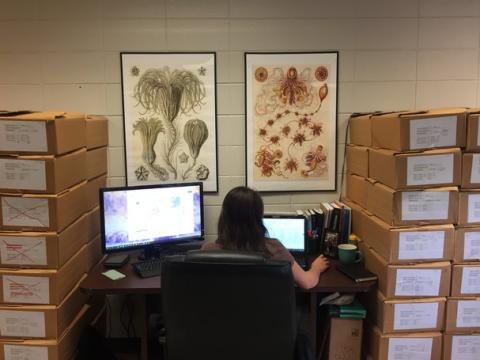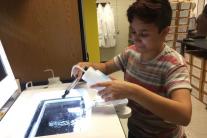Sample archive serves as a plankton ecologist's rainy-day fund
Thu, 01/10/2019 - 10:19am(Extracted from a natureINDEX article by Jeffrey M. Perkel and a UL Lafayette news item)
A massive collection of sea creatures turns out to be a gold mine of research opportunities. When Kelly Robinson started her faculty position in our biology department, her postdoctoral advisor made her an offer she couldn't refuse.
Robinson studies the distribution of and interactions between plankton - dust-mote-sized, newly hatched sea creatures. To collect them, Robinson must charter a boat that can ferry her team into the warm waters of the Gulf of Mexico and Straits of Florida - an expensive proposition. So, when her advisor offered her all the previously harvested ocean water she could carry, Robinson leapt at the opportunity. Counting the dollar value of grants awarded to collect them, plus ship time, "It was something like 4 million dollars worth of NSF samples just sitting there for free. I was like, 'I'll take it'," she says.

For Robinson, the samples provide a hedge against the vagaries of grant funding. "It's a rainy-day data fund," she explains. "If I'm in a lean year where I don't have any projects funded, I have a bunch of data that I can just work with already." But utilizing that collection turns out to be easier said than done. Those 4 million dollars worth of samples amounted to some 11,640 one-litre plastic containers full of plankton and preservative - enough to fill a small moving truck. It didn't need to be refrigerated, but it did need to be stored somewhere - mostly, her lab. In photographs, her two-room lab is filled with piles of cardboard boxes, up to 12 high, Robinson says. "The students actually use them to create little divisions for their spaces, like little forts."
To learn more about this interesting topic, please take a look at Jeffrey M. Perkel's natureINDEX article. You may also be interested in this nature TOOLBOX item describing how Robinson and her coworkers use artificial intelligence to help them analyze millions of images.
Photo info: (Image 1) Victoria Gomez, a sophomore undergraduate student at UL Lafayette, prepares a zooplankton sample for processing with a bench-top plankton imaging system called a ZooScan. (Kelly Robinson photo)
Photo info: (Image 2) Sara 'River' Dixon, a first year PhD student in the Biology Department at the University of Louisiana at Lafayette, studies diligently between towers of boxes containing hundreds of zooplankton samples. She, and three other graduate students, use the boxes to create personal work spaces in the lab. (Kelly Robinson photo)

